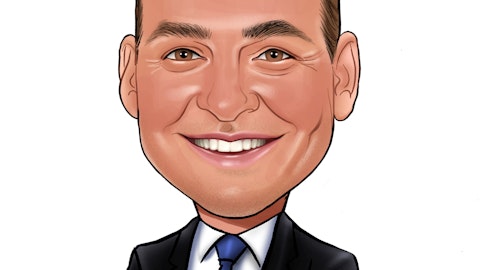Patriot Transportation Holding, Inc. (NASDAQ:PATI) Q1 2023 Earnings Call Transcript February 2, 2023
Company Representatives: Rob Sandlin – President, Chief Executive Officer Matt McNulty – Chief Financial Officer, Chief Operating Officer John Klopfenstein – Chief Accounting Officer
Operator: Good afternoon, and welcome to the Patriot Transportation Holdings Incorporated Earnings Call for the First Quarter of 2023. At this time all participants are placed on a listen-only mode and the floor will be open for questions and comments after the presentation. It is now my pleasure to turn the floor over to your host, Mr. Rob Sandlin, President and CEO of Patriot Transportation. Sir, the floor is yours.
Rob Sandlin: Thank you. Good afternoon and thank you all for being on the call today and for your interest in Patriot Transportation. I am Rob Sandlin, CEO of Patriot Transportation and with me today are Matt McNulty, our Chief Financial Officer and Chief Operating Officer; and John Klopfenstein, our Chief Accounting Officer. Before we get into our results, let me caution you that any statements made during this call that relate to the future are by their nature subject to risks and uncertainties that could cause actual results and events to differ materially from those indicated by such forward-looking statements. Additional information regarding these and other risk factors and uncertainties may be found in the company’s filings with the Securities and Exchange Commission.

Photo by Rodrigo Abreu on Unsplash
Now, for our first quarter results. Today, the company reported a net income of $485,000 or $0.14 per share for the quarter ended December 31, 2022, compared to net income of $6,439,000 or $1.74 per share in the same quarter last year, which included $6,281,000 or a or $1.70 per share from after tax gains on real estate. Operating revenues for the quarter were $22,850,000 up $2,279,000 from the same quarter last year, due to rate increases, higher fuel surcharges and improved business mix. Miles this quarter were down $299,000, partially due to the closing of our Nashville location and the lower driver count. Operating revenue per mile was up $0.66 or 17.5%. Compensation and benefits increased $1,121,000, mainly due to the increased driver compensation package, mostly offset by lower driver count and a reduction in support staff.
Depreciation expense was down $203,000 in the quarter and gains on sales of assets was $66,000 compared to $360,000 gain in last year’s quarter. The operating profit for this quarter was $620,000 compared to $8,541,000 in last year’s first quarter. For the Summary and Outlook, looking back at our 2022 year, we focused on adding business with new and existing customers that meets our stated goal of adding quality business that provides for an acceptable return on investment. As we began our 2023 year, we added business with new and existing customers throughout the quarter and have new business opportunities booked going forward into the second quarter. We had $7,800,000 of cash at the end of the ï¬rst quarter with no outstanding debt. Interest rates continue to rise in the calendar for 2022, which will put more pressure on those in the industry with large outstanding debt.
We will add 73 tractors during our year and received nine during the quarter. 44 of the tractors will replace our existing company fleet and 29 will replace lease tractors with company owned tractors. We believe replacing the 29 leased tractors with company units will provide a better ï¬nancial result and is a good use of our cash. We will only add a small number of trailers during 2023 and hopes that inflation declines going forward, and replacement prices, price surcharges also decline, allowing us to replace more trailers down the road at a lower price. We will continue to focus on our driver hiring and retention. During the quarter, we raised pay on our drivers in most of the markets where pay was not adjusted late in our 2022 year.
The results among our drivers with a year or more of seniority has been very positive, resulting in low turnover among this group of dedicated professionals. New driver acquisitions while slightly improved, continues to result in high turnover, but with slightly better results than this time last year. As general freight spot rates have declined, we have experienced the ability to put on more owner operators in several markets and will continue to monitor and balance this with company drivers. In closing, we are on target with our safety goals for the ï¬rst quarter of the year and we’ll continue to focus to keep preventable incidents and costs in check. Generally, the petroleum and construction industry business increases during our second quarter, and we believe we are positioned well to take additional advantage of seasonal volume increases, along with committed new business.
Thank you again for your interest in our company, and we will be happy to entertain any questions.
See also 12 Top Performing Energy Stocks in January and 30 Most Famous Yale Students of All Time .
Q&A Session
Follow Patriot Transportation Holding Inc. (NASDAQ:PATI)
Follow Patriot Transportation Holding Inc. (NASDAQ:PATI)
Receive real-time insider trading and news alerts
Operator: Thank you. . Thank you. Our first question is coming from Christian Olesen with Olesen Value Fund. Please go ahead.
Christian Olesen: Thank you. I just wanted to see if you guys could talk a little bit more about your other goals, plans and expectations for rate increases in the first calendar quarter of 2023 and maybe the following quarter as well?
Rob Sandlin: Yeah Christian, thanks for being on the call and for your question. I think the best way to answer that is we have budgeted the majority of our price increases in the ï¬rst and second quarter of this year, and they are going along as planned and we feel like the market is still allowing for additional rate. Certainly, some of that is continuing to help us cover this added driver cost, but also some of the inflation that we’re seeing, but I would say so far so good.
Christian Olson: Okay, great. And in terms of driver pay, could you comment a bit more on that, just the pressures in the industry overall, is it abating much? And is there any difference comparing tank truck drivers to truck drivers more generally?
Rob Sandlin: Yes, I think you can always draw. The ï¬rst thing I would say is you can always draw a comparison between the over the road driver that is out there for, let’s say weeks at a time and our drivers in the tank truck industry, particularly ours that are more regional in nature and they are mostly home at night. I think from a compensation standpoint, our drivers typically do better than a new driver that’s over the road, plus their home with their family. So I think we got a little bit of an advantage there. That is the way that most people break into the industry though, is getting in that long haul side of the business. So they’ve got to want to change jobs, and in fact I was talking to one of our drivers last year that was out on the road for 16 years, and he’s really happy to be home.
He was gone six weeks at a time, and he’s working for us, and he said he’s making more money. So that’s kind of a real life example there. The driver pay increases that we did so far this year and we had planned, where four €“ five or six of our terminals that had not had driver pay increases in the latter half of the year. And so while we’ve seen some, I would say we’ve raised the pay a lot over the last, since April of ’21. I think we save between 25% and 35%. And so we think the biggest part of that work is done. Certainly, with inflation where it is, there’s going to be some expectation on a routine basis to do something, but I think real large chunks of that are behind us.
Christian Olson: Okay, thank you very much.
Rob Sandlin: Sure. Thank you.
Operator: Thank you. Our next question is coming from John Koller with Oppenheimer & Close. Please go ahead.
John Koller: Good afternoon gentlemen.
Rob Sandlin: Hello John.
John Koller: A couple of questions if I could. Usually on these calls you give us some idea of the number of drivers and any that you’ve added. I was wondering if you can provide that information and I’m also curious about how those efforts that you had to recruit and get new drivers into training, how those are progressing or have they largely petered out because it was not delivered as you might have expected.


